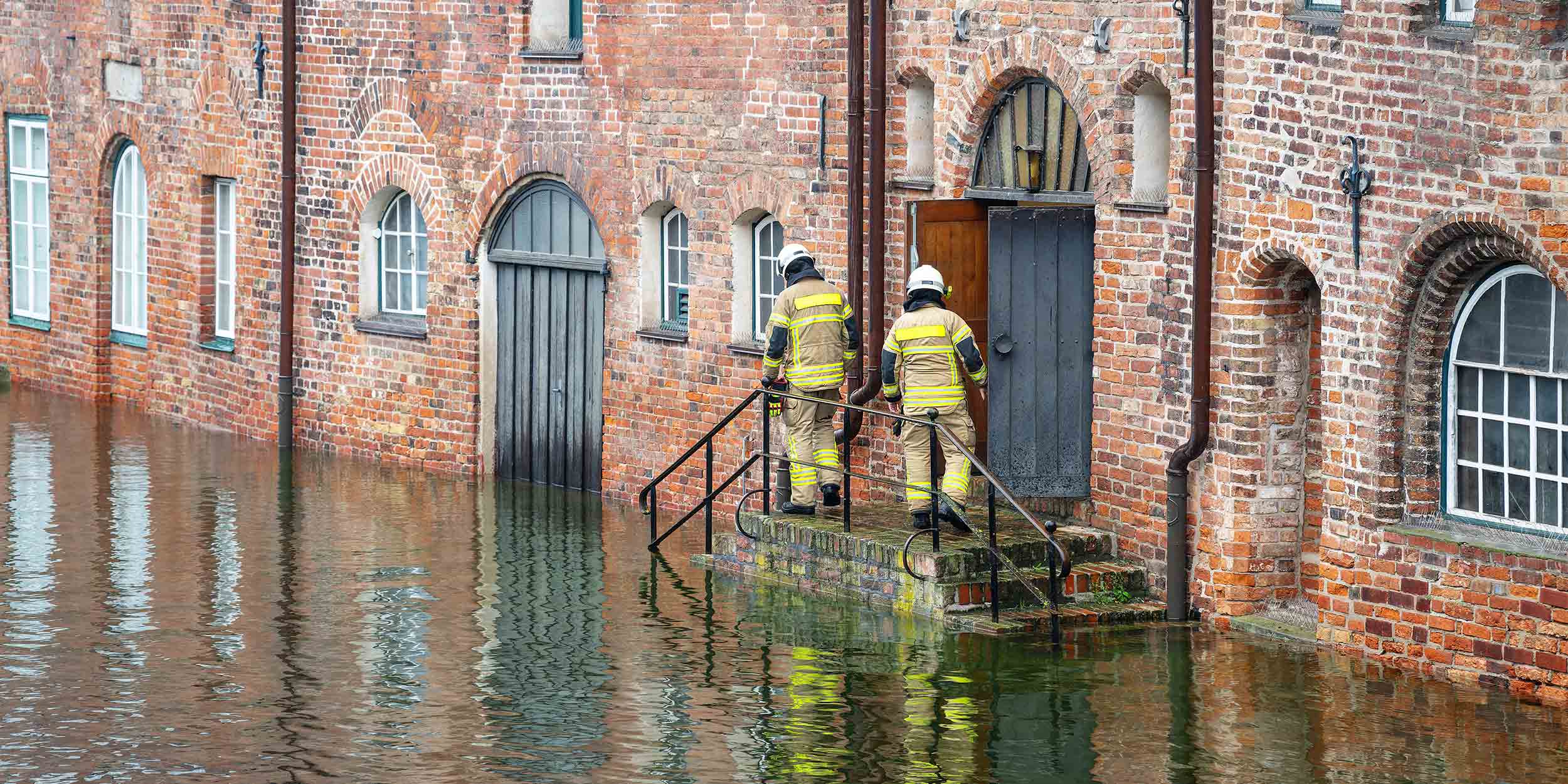From risk to resilience: building an impactful strategy for climate adaptation
Climate ChangeArticleJuly 16, 2025
As physical climate risks intensify, businesses are accelerating investments in climate adaption strategies.
Every USD 1 spent on climate-related adaptation measures today generates more than USD 10 in benefits over the next decade. With the guidance of risk managers and sustainability teams, businesses can turn today’s adaption measures into tomorrow’s resilience, according to Risto Schmid, Head Climate Resilience Switzerland, Zurich Resilience Solutions and Nadine Janser, Senior Business Development Manager, Climate Resilience, Zurich Resilience Solutions.
The widespread flooding and landslides that devastated parts of Central Europe last summer not only cost human lives and paralyzed communities, but also caused economic challenges for businesses both locally and around the world. While regional businesses suffered closures, productivity decline and reduced demand, there was also a ripple effect across global supply chains that ran through the region.
In Valencia, for example, several key warehouses and distribution centers flooded, while major agricultural producers in Poland and the Czech Republic were severely damaged. Meanwhile, a key aluminum producer in Switzerland was forced to pause production, causing major disruption in the automotive sector.
Climate scientists believe that anthropogenic climate change is making floods more frequent and intense. Last summer’s experience is a wakeup call that acute risks like these are already impacting the margins and balance sheets of businesses today.
It is also a critical lesson about the importance of putting enterprise risk management and sustainability strategies at the heart of achieving climate resilience. For example, these events exposed companies with vulnerable risk concentrations in their supply chain.
At the same time, it is crucial not to overlook chronic risks such as droughts and heatwaves. Only recently, a heatwave caused river temperatures to rise at a nuclear power plant in Switzerland, forcing one reactor to shut down and another to reduce output by half to protect the local environment. Generally, although they often receive less immediate attention than acute events, chronic risks are coming under increasing scrutiny, particularly in industries that depend directly on the availability of natural resources such as water.
Missing the Paris ambition: business implications
For the past decade, most of the corporate efforts to address climate-related risks have focused on mitigating the effects of climate change. This has meant decarbonising business models and partaking in initiatives to meet the 2015 Paris Agreement’s ambition of limiting global warming to 1.5 degrees above pre-industrial levels, and dedicating substantial resources for related reporting activities.
Ten years on, however, this ambition has become almost unobtainable. Last year was the warmest on record and, with global emissions continuing to rise and international climate action plateauing, the world is currently on track to warm 2.9 degrees by 2100, according to the United Nations Environment Programme.
The Intergovernmental Panel on Climate Change (IPCC) is clear about what this means for our climate: more frequent and intense flooding, worsening water-scarcity, heatwaves that exceed critical tolerance thresholds, and extended ‘fire-weather’ seasons. This in turn will have far-reaching effects on business models and operations, supply chains and infrastructure around the globe.
The imperative for businesses is clear: Now is the time to expand their focus beyond climate mitigation to include complementary and often mutually beneficial adaptation strategies. By anticipating how physical climate risks may affect their organization and taking proactive steps, companies can strengthen their resilience and hence financial performance. In short, risk managers and sustainability experts play a key role in protecting their businesses from potential revenue losses, asset damage, and rising financing and insurance costs.
The risk manager’s unique perspective and mandate
The shift from a complementary mitigation and adaptation approach requires both long-term planning and near-term and often location-specific actions, and demands an enterprise-wide oversight of physical climate risk that extends to the supply chain.
In our experience, organizations leading the way are continually improving their risk governance practices and following the risk management process to embed climate resilience into decision-making across the organization, both locally and globally.
Also, many businesses have an opportunity for success by encouraging greater collaboration between sustainability, finance, operations, risk and insurance teams. The most impactful strategies are built on a holistic response, and risk professionals are well-placed to lead this process, bringing together different functions from across the organization. Their experience in managing a broad range of long-term risks and their detailed knowledge of a company’s global operations and related financial acumen give them a unique vantage point.
Four key considerations in an effective climate risk management process
Each company must carve its own bespoke path to climate resilience, but there are several common themes underlying best practice.
First, high-quality data that provides confidence through transparency and consistency. The first step in creating an adaptation strategy is identifying and assessing an organization’s exposure to current and future physical climate risks at group-level. This demands granular data that reflects the risks material to the business and ideally highlights the most critical and vulnerable locations in the value chain across different IPCC scenarios that require focused risk management. While companies can access open-source data, they should be aware that it often lacks the flexibility, transparency and detail of proprietary datasets.
Take the example of an agricultural business assessing the impact of extreme heat on future productivity. Key decisions may balance on details such as average versus peak temperatures, humidity levels and temperature ranges during harvesting seasons. The data must also reflect the different heat tolerance of, for example, crop yields compared to that of worker safety. To provide a clearer understanding of these risks, Zurich Resilience Solutions, for example, use specific heat metrics pertinent to the risk considered such as the average annual number of days above 35°C, heat stress (felt temperature) experienced by workers, and the duration of heatwaves. These metrics help organizations quantify how both sustained and extreme heat can affect worker health and crop yields, supporting more confident and targeted adaptation decisions.
Second, from loss quantification to the development of site-specific loss scenarios. While some software solutions already enable the modelling of expected losses from specific physical climate risks at the site level, this is only the first step in the journey. It is through dedicated, on-site climate change assessments that the complex interconnections and combined effects of various risks—such as water shortages occurring alongside rising temperatures—can be fully understood. By incorporating input from the customer’s business, a climate risk engineer can use these insights to develop site-specific loss scenarios and propose tailored adaptation measures to strengthen the site’s resilience.
Third, early intervention of adaptation measures. A topic that requires a long-term mindset can be at odds with the typical three-to-five-year business outlook. However, research shows that for every USD 1 spent on climate-related adaptation measures today, USD 10 can be saved over the subsequent decade.
For example, it is much more cost-effective to build a flood-resistant factory today with elevated foundations, robust drainage systems and climate-resilient materials, than it is to retrofit the factory in the long-run. Similarly, by selecting new sites with lower exposures to deteriorating weather patterns, companies can ensure the long-term viability and sustainability of the project.
When assessing these investments, it is important though to factor in their potential to reduce losses to understand their effectiveness.
Fourth, supply chain management. Natural disasters are one of the leading causes of supply chain disruption globally – but building climate resilience into a complex, multi-national supply chain is a significant challenge that even pioneering companies are grappling with. In Europe, only nearly half of organizations already factor climate risk into supply chain considerations. Over the last five years, however, supplier mapping has received more investment, which should support greater scrutiny of tier 1 suppliers and beyond, according to a recent BCI Report.
Once companies have identified risk concentrations and conducted site-level assessments for the most critical suppliers (often only Tier 1), they have, in theory, two options. The first is to encourage existing suppliers to become more climate resilient. The second is to further diversify the supplier base, and in some extreme cases, relocate entire supply chains to lower-risk regions.
Collaborating for success
In our experience, companies are at varying degrees of preparedness for physical climate risk. Larger enterprises are typically further along the maturity curve but even the most prepared need to continually adapt and adjust as risks and stakeholder expectations evolve.
Turning climate and exposure data into a meaningful risk management process at global and local level is challenging even for the most advanced organizations. As a result, there has been a notable uptick in businesses bringing in external expertise to support with physical climate risk management. Risk advisors, who offer both global and location-specific expertise, which includes engagement of local communities, are uniquely positioned to support companies in the identification and prioritization of actions, as well as in-depth local assessments and practical advice on risk response measures.
What is clear is that climate adaptation is essential for businesses’ long-term success and requires a well-orchestrated enterprise risk management approach. Together with the support of specialists, this is an exciting opportunity for risk professionals to lead the collaborative effort within their organization and become an important stakeholder in shaping the sustainability strategy and implementing the requisite plan.
Originally published in Commercial Risk on July 16, 2025.


